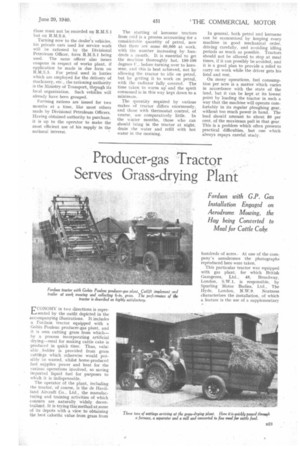Farmers' Fuel Problems
Page 56

Page 57

If you've noticed an error in this article please click here to report it so we can fix it.
and what they involve
FUEL problems in connection with 1 agricultural machinery belong rather to a class of their own, inasmuch as both petrol and kerosene or paraffin are involved. In war-time,. the questions which arise concern not only the efficient use of the fuel, but also the
difficulties which may arise in connection with rationing.
Whilst kerosene for use in machinery is not rationed, its. use in vehicles licensed for road work is prohibited. It should be noted that this does not apply to farm tractors using roads by virtue of an exemption permit, or on a 5s. licence, or on the reduced rate of taxation applying to farmers' tractors used for limited road haulage.
A simple test to apply in any particular case is to consider whether the machine is licensed to haul anything apart from its own gear, or the produce of the operator's farm, or his requisites for the same. If it be, he
B22
may not use kerosene for f this
purpose on the road.
Petrol has, of course, been rationed for agricultural purposes since January 1, 1940, but, provided that claims are genuine and properly made, petrol for agricultural purposes is available. As some doubt still exists as to the method of securing coupons, a brief summary may be useful.
The form of application for petrol to be used in tractors, stationary engines . and vans or lorries operating on an licence, is known as R.M.S.6 and can be obtained from the usual sources, chief post offices or local taxation offices. When complete, it has to be sent to the Divisional Petroleum Officer.
This same form has to be used by ploughing contractors and by machinery dealers in respect of their requirements of petrol for use actually in .tractors or engines. Such use includes starting or demonstrating and delivering new machines, or testing engines in the course of overhaul.
This does not, of course, cover all uses of petrol in agriculture, and other needs may be briefly mentioned. The farmer's private car must be the subject of an application for supplementary rations (if required) on form R.M.S.1— the ordinary private-car form. If he uses a trailer, this should be clearly stated, as should any work done actually on the land, as distinct from road travel. There are many unlicensed, cars now used on the land as tractors, and
these must not be recorded on R.M.S.1 but on R.M.S.6.
Turning now to the dealer's vehicles, his private cars used for service work will be rationed by the Divisional Petroleum Officer, form R.M.S.1 being used. The same officer also issues coupons in respect of works plant, if application be made in due form on R.M.S.S. For petrol used in lorries which are employed for the delivery of machinery, etc., the rationing authority is the Ministry of Transport, threugh its local organization. Such vehicles will already have been grouped.
Farming rations are issued for two months at a time, like most others made by Divisional Petroleum Officers. Having obtained authority to purchase, it is up to the operator to make the most efficient use of his supply in the national interest.
The starting of kerosene tractors from cold is a process accounting-for a considerable quantity of petrol, now that there are some 60,000 at work, with the number increasing by hundreds a month. It is essential to get the machine thoroughly hot, 180-190 degrees F., before turning over to kerosene, and this is best achieved, not by allowing the tractor to idle on petrol, but by getting it to work on petrol, with the radiator fully, covered. The time taken to warm up and the spirit consumed is in this way kept down to a minimum.
The quantity required by various makes of :tractor differs enormously, and those with thermostat control, of course, use comparatively little. In the winter months, those who can should bring in the tractor at night, drain the water and refill with hot water in the morning. In general, both petrol and kerosene can be economized by keeping every machine in good mechanical order, driving carefully, and avoiding idling periods as much as possible. Tractors should not be allowed to stop at meal times, if it can possibly be avoided, and it is a good plan to provide a relief to carry on work while the driver gets his foOd and rest.
On many operations, fuel consumption per acre is a matter Which varies in accordance with the state of the land, but it can be kept at its lowest point by loading the tractor in such a way that the machine will operate comfortably in its regular ploughing gear, without too much power in hand. The load should amount to about 80 per cent. of the maximum pull in that gear. This is a problem which often presents practical difficulties, but one which always repays careful study.




























































































